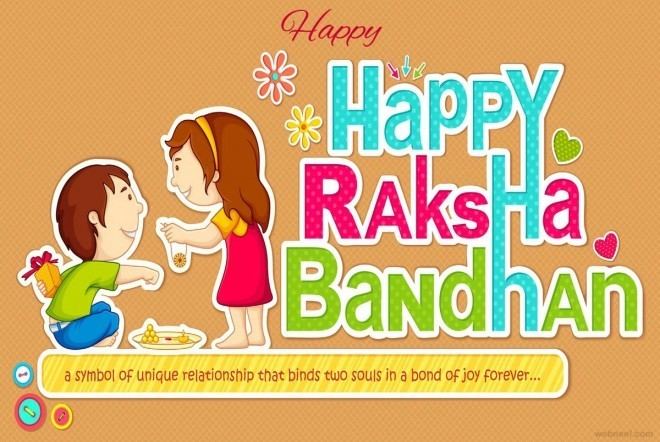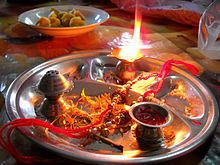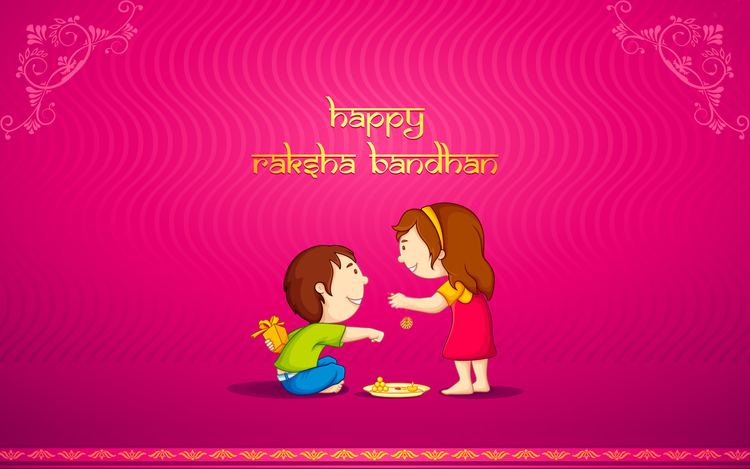Official name Raksha Bandhan. 2017 Date 7 August 2017 | Observed by Hindus Type of holiday Religious celebration | |
 | ||
Celebrations sister and brother get together, tie rakhi on wrist, perform aarti, mark tilak, brother promises to protect sister, sister feeds brother, brother gives gift, hugs Observances Celebration of any brother-sister like relationship Featured in religions Hinduism, Jainism, Sikhism Also called Rakhi, Rakhri, Nepali: रक्ष्या बन्धन ; Marathi: रक्षा बंधन ; Hindi: रक्षा बन्धन), also called as Raksha Bandhana (Kannada: ರಕ್ಷಾ ಬಂಧನ), Rakhi Purnima , (Punjabi: ਰੱਖੜੀ) | ||
Raksha Bandhan, or simply Rakhi in many parts of India and Nepal, is a Hindu religious and secular festival. Raksha bandhan means "bond of protection". It is observed on the full moon day of the Hindu luni-solar calendar month of Shravana, which typically falls in Gregorian calendar month of August.
Contents
- Raksha bandhan story rakhi festival
- Description
- Significance
- Practices
- Prepare for Raksha Bandhan
- Rakhi ritual
- Prayer aarti promise and food
- Gifts and hugs
- Myths and legends
- Indra Dev
- King Bali and Goddess Laxmi
- Santoshi Maa
- Krishna and Draupadi
- Yama and the Yamuna
- History
- Alexander the Great and King Puru
- Rani Karnavati and Emperor Humayun
- Rabindranath Tagore and the Bengal partition of 1905
- Sikh history
- Multi culturalism and activism
- Regional variations
- West Bengal and Odisha Orissa
- Maharashtra
- Jammu Kashmir
- Haryana
- Nepal
- References

The festival celebrates the love and duty between brothers and sisters. It is also popularly used to celebrate any brother-sister type of relationship between men and women who may or may not be biologically related. On Raksha Bandhan, a sister ties a rakhi (sacred thread) on her brother's wrist with a prayer for his prosperity and happiness. This symbolizes the sister's love. The brother gives her a token gift and a promise to protect her.

Raksha Bandhan is primarily observed by Hindus in northern and western India, Mauritius and Nepal. It is also celebrated by Hindus and Sikhs in parts of Pakistan, and by the diaspora from India and Nepal that have settled elsewhere. The festival is also observed by Jains as a religious festival, wherein Jain priests give threads to devotees. Raksha Bandhan has been an important tradition in the history of Sikhism as well, sometimes referred to as Rakhardi or Rakhari.

Raksha bandhan story rakhi festival
Description

Raksha Bandhan as a religious festival focuses on performing the aarti and saying prayers prior to tying the rakhi. The prayers draw inspiration from the Hindu scriptures.
Significance
Raksha Bandhan in Sanskrit literally means "the tie or knot of protection". The word Raksha means protection, while Bandhan is the verb to tie. It is an ancient Hindu festival that ritually celebrates the love and duty between brothers and their sisters. The sister performs a rakhi ceremony, then prays to express her love and her wish for the well being of her brother; in return, the brother ritually pledges to protect and take care of his sister under all circumstances. It is one of the several occasions in which family ties are affirmed in India.
The festival is also an occasion to celebrate brother-sister like family ties between cousins or distant family members, sometimes between biologically unrelated men and women. To many, the festival transcends biological family, brings together men and women across religions, diverse ethnic groups and ritually emphasizes harmony and love. It is observed in the Hindu calendar month of Śrāvaṇa, and typically falls in August every year.
Practices
The festival is marked by the several rituals, which vary regionally within India. Typical rituals include:
Prepare for Raksha Bandhan'
Days or weeks before Raksha Bandhan, women shop for rakhi, the ceremonial thread to tie around her brother's (or brother-like friend's) wrist. Some women make their own rakhi. A rakhi may be a simple thread, woven and colorful, or may be intricate with amulets and decorations. Sometimes, a rakhi may be a fancy watch or men's wrist accessory in the form of bracelet or jewelry. Rakhi in the form of a colorful woven thread is most common. Typically the brother also shops for gifts for his sister, ahead of Raksha Bandhan. The gift from the brother can be a simple thoughtful token of love, and may be more elaborate.
Rakhi ritual
On the morning of Raksha Bandhan the brothers and sisters get together, often in nice dress in the presence of surviving parents, grandparents and other family members. If the sister and brother are geographically separated, the sister may mail the rakhi ahead of the Raksha Bandhan day, along with a greeting card or letter wishing her brother well. The ritual typically begins in front of a lighted lamp (diya) or candle, which signifies fire deity. The sister and brother face each other. The sister ties the rakhi on her brother's wrist.
Prayer, aarti, promise and food
Once the rakhi has been tied, the sister says a prayer for the well being of her brother – good health, prosperity and happiness. This ritual sometimes involves an aarti, where a tray with lighted lamp or candle is ritually rotated around the brother's face, along with the prayer and well wishes.
The prayer is a self composed note, or one of many published Rakhi poems and prose. One of the earliest examples of a Rakhi prayer is found in Book V, Chapter V of Vishnu Purana; it is the prayer that Yasoda says while tying a Raksha Bandhan amulet on Krishna's wrist. An abridged form of this prayer is:
After the prayer, the sister applies a tilak (tikka), a colorful mark on the forehead of the brother. After the tilak, the brother pledges to protect her and take care of his sister under all circumstances.
The sister then feeds the brother, with her hands, one or more bites of sweets (desserts), dry fruits and other seasonal delicacies.
Gifts and hugs
The brother gives his sister(s) gifts such as cards, clothes, money or something thoughtful. The brother may also feed his sister, with his hands, one or more bites of sweets, dry fruits and other seasonal delicacies. They hug, and the larger family ritually congratulate the festive celebration of brother-sister love and protection.
The brothers wear the rakhi for the entire day, at school or work, as a reminder of their sisters and to mark the festival of Raksha Bandhan.
Myths and legends
The scriptures, epics of Hinduism is peppered with stories of rakhi and Raksha Bandhan. Some of these include:
Indra Dev
According to Bhavishya Purana, in the war between Gods and demons, Indra – the deity of sky, rains and thunderbolts – was disgraced by the powerful demon King Bali. Indra’s wife Sachi consulted Vishnu, who gave her a bracelet made of cotton thread, calling it holy. Sachi tied the holy thread around Indra wrist, blessed with her prayers for his well being and success. Indra successfully defeated the evil and recovered Amaravati. This story inspired the protective power of holy thread. The story also suggests that the Raksha Bandhan thread in ancient India were amulets, used by women as prayers and to guard men going to war, and that these threads were not limited to sister-brother like relationships.
King Bali and Goddess Laxmi
According to Bhagavata Purana and Vishnu Purana, after Vishnu won the three worlds from the demon King Bali, Bali asked Vishnu to stay with him in his palace, a request Vishnu granted. Vishnu's wife, Goddess Lakshmi did not like the palace or his new found friendship with Bali, and preferred that her husband and she return to Vaikuntha. So she went to Bali, tied a rakhi and made him a brother to her. Bali asked her what gift she desired. Lakshmi asked that Vishnu be freed from the request that he live in Bali's palace. Bali consented, as well accepted her as his sister.
Santoshi Maa
Ganesh had two sons, Shubh and Labh. The two boys become frustrated that they have no sister to celebrate Raksha Bandhan with. They ask their father Ganesh for a sister, but to no avail. Finally, saint Narada appears who persuades Ganesh that a daughter will enrich him as well as his sons. Ganesh agreed, and created a daughter named Santoshi Maa by divine flames that emerged from Ganesh's wives, Ruddhi (Amazing) and Siddhi (Perfection). Thereafter, Shubh Labh (literally "Holy Profit") had a sister named Santoshi Maa (literally "Goddess of Satisfaction"), for Raksha Bandhan.
Krishna and Draupadi
In the epic Mahabharat, Draupadi tied a rakhi on Krishna, while Kunti tied her rakhi on her grandson Abhimanyu, before the great war.
Yama and the Yamuna
According to another legend, Yama, the god of Death, had not visited his sister Yamuna for 12 years. Yamuna was sad and consulted Ganga. Ganga reminded Yama of his sister, upon which Yama visits her. Yamuna was overjoyed to see her brother, and prepared a bounty of food for Yama. The god Yama was delighted, and asked Yamuna what she wanted for a gift. She wished that he, her brother should return and see her again soon. Yama was moved by his sister's love, agreed and to be able to see her again, made river Yamuna immortal. This legend is the basis for a Raksha Bandhan-like festival called Bhai Duj in some parts of India, which also celebrates brother-sister love, but near Diwali.
History
Raksha Bandhan is an ancient festival of the Indian subcontinent, and its history dates back thousands of years.
Alexander the Great and King Puru
According to one legendary narrative, when Alexander the Great invaded India in 326 BCE, Roxana (or Roshanak, his wife) sent a sacred thread to Porus, asking him not to harm her husband in battle. In accordance with tradition, Porus, the king of Kaikeya kingdom, gave full respect to the rakhi. In the Battle of the Hydaspes, when Porus saw the rakhi on his own wrist and restrained himself from attacking Alexander personally.
Rani Karnavati and Emperor Humayun
Another controversial historical account is that of Rani Karnavati of Chittor and Mughal Emperor Humayun, which dates to 1535 CE. When Rani Karnavati, the widowed queen of the king of Chittor, realised that she could not defend against the invasion by the Sultan of Gujarat, Bahadur Shah, she sent a rakhi to Emperor Humayun. The Emperor, according to one version of the story, set off with his troops to defend Chittor. He arrived too late, and Bahadur Shah had already sacked the Rani's fortress. Alternative accounts from the period, including those by historians in Humayun's Mughal court, do not mention the rakhi episode and some historians have expressed skepticism whether it ever happened. Humayun's own memoirs never mention this, and give different reasons for his war with Sultan Bahadur Shah of Gujarat in 1535.
Muslim commentators in modern era publications mention this story as evidence of Muslim-Hindu communal ties in the past.
Rabindranath Tagore and the Bengal partition of 1905
Rabindranath Tagore, the Indian Nobel Laureate for literature, invoked Raksha Bandhan and rakhi as concepts to inspire love, respect and a vow of mutual protection between Hindus and Muslims during India's colonial era. In 1905, the British empire divided Bengal, a province of British India on the basis of religion. Rabindra Nath Tagore arranged a ceremony to celebrate Raksha Bandhan to strengthen the bond of love and togetherness between Hindus and Muslims of Bengal, and urge them to together protest the British empire. He used the idea of Raksha Bandhan to spread the feeling of brotherhood. In 1911, British colonial empire reversed the partition and unified Bengal, a unification that was opposed by Muslims of Bengal. Ultimately, Tagore's Raksha Bandhan-based appeals were unsuccessful. Bengal not only was split during the colonial era, one part became modern Bangladesh and predominantly Muslim country, the other a largely Hindu Indian state of West Bengal. Rabindranath Tagore started Rakhi Mahotsavas as a symbol of Bengal unity, and as a larger community festival of harmony. In parts of West Bengal, his tradition continues as people tie rakhis to their neighbors and close friends.
One of Tagore's poem invoking rakhi is:
Sikh history
In the 18th century, states Arvind-Pal Singh Mandair, Sikh Khalsa armies introduced the term Rakhi (Raksha Bandhan) as a promise of protection to farmers from Muslim armies such as those of the Mughals and Afghans, in exchange for sharing a small cut of their produce.
Maharaja Ranjit Singh was the founder and ruler of the Sikh Empire, and he observed Raksha Bandhan festival. His wife Maharani Jindan sent a Rakhi to the ruler of Nepal, who accepted her as sister and gave her refuge in the Hindu kingdom of Nepal in 1849 after the collapse of the Sikh Empire and annexation of its territories by the British.
Sikhs have observed Raksha Bandhan festival, and has sometimes been referred to as Rakhardi (literally, wristband) or Rakhari in historic Sikh texts. Like the Hindu tradition, the festival has involved the tying of the rakhi and giving of gifts.
Multi-culturalism and activism
Some Muslims in India view it a secular, multicultural festival. Raksha bandhan has also been adopted by the Christian community in India who view it as a festival of historical and social importance.
In 2015, men tied rakhis on women seeking protection from the ‘misuse’ of section 498A of the Indian Penal Code. "Society has gone through massive changes in the last few decades and men are now considered on the same platform with women. Why should laws show a discrimination against them?" asked Amartya Talukdar, founder member of Hridaya, an NGO working for gender neutrality.
Regional variations
While Raksha Bandhan is celebrated in various parts of South Asia, different regions mark the day in different ways.
West Bengal and Odisha (Orissa)
In the state of West Bengal and Odisha, this day is also called Jhulan Purnima. Prayers and puja of Lord Krishna and Radha are performed there. Sisters tie rakhi to brothers and wish immortality. Political parties, offices, friends, schools to colleges, street to palace celebrate this day with a new hope for a good relationship.
Maharashtra
In Maharashtra, the festival of Raksha Bandhan is celebrated along with Narali Poornima (coconut day festival). Kolis are the fishermen community of the coastal state. The fishermen offer prayers to Lord Varuna, the Hindu god of Sea, to invoke his blessings. As part of the rituals, coconuts were thrown into the sea as offerings to Lord Varuna. The girls and women tie rakhi on their brother's wrist, as elsewhere.
Jammu (Kashmir)
In the regions of North India, mostly Jammu, it is a common practice to fly kites on the nearby occasions of Janamashtami and Raksha Bandhan. It's not unusual to see the sky filled with kites of all shapes and sizes, on and around these two dates. The locals buy kilometres of strong kite string, commonly called as "gattu door" in the local language, along with a multitude of kites.
Haryana
In Haryana, in addition to celebrating Raksha Bandhan, people observe the festival of Salono. Salono is celebrated by priests solemnly tying amulets against evil on people's wrists. As elsewhere, sisters tie threads on brothers with prayers for their well being, and the brothers give her gifts promising to safeguard her.
Nepal
In Nepal, Raksha Bandhan is referred to as Janai Purnima or Rishitarpani, and involves a sacred thread ceremony. It is observed by both Hindus and Buddhists of Nepal. The Hindu men change the thread they wear around their chests (janai), while in some parts of Nepal girls and women tie rakhi on their brother's wrists. The Raksha Bandhan-like brother sister festival is observed by other Hindus of Nepal during one of the days of the Tihar (or Diwali) festival.
